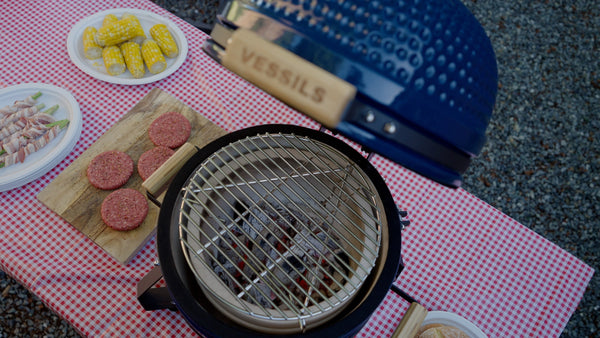
How Much Charcoal Do You Really Need for Each Cooking Style?
Fueling Your Fire
Whether you're firing up a grill for weeknight steaks or prepping for a full-day barbecue session, one question always arises: how much charcoal do I really need?
Getting the answer right makes the difference between frustrating flameouts and beautifully cooked meals. But the truth is, there's no universal answer—charcoal quantity for BBQ depends on cooking style, temperature goals, grill type, and even outdoor conditions.
In this article, we’ll explore how to determine the right amount of charcoal for grilling, whether you're direct-grilling a few burgers or smoking a brisket for hours. With insights tailored for kamado users and supported by Vessils' trusted line of grills, you’ll learn how to master charcoal efficiency one cook at a time.
Factors Influencing Charcoal Quantity
Getting the right burn starts with these key variables:
-
Cooking Style: Direct vs. Indirect, Quick Grilling vs. Low & Slow Smoking (Direct vs Indirect Cooking on a Charcoal Grill).
-
Grill Type & Size: Kamado grills, like the Vessils Classic Full-Size 19", are insulated and usually require less charcoal.
-
Charcoal Type: Lump charcoal burns faster and hotter than briquettes (What Charcoal is Best for Kamado Grills?).
-
Ambient Conditions: Cold temperatures and high winds increase charcoal consumption.
-
Duration: Hour-long searing sessions need less fuel than 10-hour rib smokes.
-
Food Volume: More food usually requires longer or more consistent heat output.
Charcoal for Direct Heat Grilling
Direct grilling is all about high heat over a short period—ideal for hamburgers, chicken thighs, or quick vegetable sears.
Setup
Lay a single, even layer of lit charcoal across the coal grate right under where your food will cook.
How Much Charcoal to Use
-
Small/Quick Cooks (e.g., burgers, Kamado Grilled Chicken Thighs):
-
Use ½ to ¾ of a standard charcoal chimney with lump charcoal.
-
-
Medium Cooks (e.g., several steaks or kabobs):
-
Use a full chimney starter for broader coverage and extended heat.
-
-
High-Heat Searing (e.g., Seared Tuna Steaks with Sesame Crust):
-
Use a full chimney, ensure coals are red-hot and fully ashed before searing.
-
Tip: For intense heat, keep coals densely packed near the cooking zone.
Charcoal for Indirect Heat Grilling
Indirect grilling is perfect for roasting, baking, and moderate-length smokes like whole chickens or pork loins.
Setup
Use a two-zone setup: lit coals on one side, food on the other. For longer cooks, consider a ring or snake method. Kamado users often take advantage of ceramic heat retention and indirect cookware.
How Much Charcoal to Use
-
Short Indirect Cooks (chicken legs, stuffed peppers):
-
½ to ¾ full chimney, banked to one side.
-
-
Medium-Length Cooks (whole chickens, pork loin):
-
Full chimney starter in a two-zone arrangement.
-
-
Long, Low & Slow Cooks (brisket or Kamado Grilled BBQ Short Ribs):
-
Kamado Grill: Fill ½ to ¾ of the firebox with unlit lump charcoal and place a handful of lit coals on one end. Manage with top and bottom vents for 8–12+ hour burns.
-
Traditional Kettle Grill: Start with one full chimney of lit coals and build a snake method around the perimeter for long-haul heat.
-
Tip: Use a drip pan and deflector to maintain even cooking and reduce flare-ups.
Optimizing Charcoal Usage and Efficiency
Kamado grills excel at fuel efficiency due to their insulated ceramic design. Here’s how to stretch your charcoal further:
-
Airflow Management: Controlling oxygen with precision using venting systems (How to Control Temperature in a Kamado Grill) lets you burn less fuel across longer cooks.
-
Reuse Charcoal: Save and relight leftover unburned chunks from previous sessions.
-
Use a Charcoal Chimney: This tool (All Accessories) improves lighting efficiency and provides a quick way to measure out consistent amounts.
-
Choose Quality Charcoal: Dense, clean-burning lump charcoal lasts longer and burns hotter with fewer additives.
Troubleshooting Charcoal Quantity Issues
Too Little Charcoal?
-
Grill won’t reach temp, and food takes longer to cook.
-
Solution: Add more lit charcoal and adjust vents to fuel the fire.
Too Much Charcoal?
-
Grill runs too hot, hard to manage temperature.
-
Solution: Close down vents, use a ceramic heat deflector, or safely remove some fuel.
Keep Monitoring: Invest in a quality grill thermometer to maintain control throughout your cook.
The Art of Fuel Management
When it comes to knowing how much charcoal for grilling, awareness of your goals, food, setup, and grill types will inform the best approach. Charcoal isn't just fuel—it's a tool to deliver heat, flavor, and finesse.
With practice and a few thoughtful tweaks, you'll learn exactly how much charcoal you need for any grill day.
Explore Vessils' full line of grills and accessories to build a smarter, more efficient grilling station. And for more ideas and examples, dive into our Learning Hub to put what you’ve learned into action.



